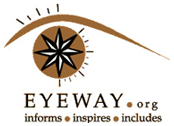Aaron Scheidies wasn’t going after any records Sunday morning at the 26th annual Sabates Eye Centers Trolley Run. Scheidies had just come off the Boston Marathon and wanted to take it easy on his legs, even though the Trolley Run is just 4 miles long.
Photos by Susan Pfannmuller | Special to The Star Severally visually impaired runners competed with the aid of guides in Sunday’s Trolley Run. Among them were Lex Gillette (right) of San Diego and guide Brighyan Clifton of Kansas City, and Markeith Price (back right) of San Diego and guide Ryan Ortiz of Colorado Springs.
What drew this elite runner from his Seattle home was the cause: The Trolley Run supports the training and therapy provided by the Children’s Center for the Visually Impaired.
Scheidies himself is visually impaired, as were four other runners who came from around the country to compete in the Trolley Run this year. Organizers believe it’s the first time blind runners have been in the race. Their trip was arranged by the U.S. Association of Blind Athletes to inspire other people who are visually impaired and to raise public awareness.
“We can compete right up there with the sighted world,” Scheidies said.
The Trolley Run is the largest timed 4-mile race in the United States. It drew about 9,500 runners last year, and organizers were hoping for 10,000 Sunday. But the iffy weather forecast may have kept the number down to about 9,000.
The race route took runners on an easy jaunt from Waldo to the Country Club Plaza. Most of the route is along Brookside Boulevard, and it’s generally flat or downhill.
“It’s a great opportunity to set a personal record,” said Trolley Run spokeswoman Traci Todd Murphy.
Not for Scheidies.
“I’m not running this hard,” Scheidies said. “From Boston, my legs are pretty sore. ”Scheidies was fully sighted until he was 9. Then a genetic form of macular degeneration progressively damaged his retinas. The condition took away the central part of his visual field and left most everything else in a blur. His childhood dreams of becoming a professional soccer player were over, but he soon found success at swimming and cross country in high school and excelled as a triathlete.
Scheidies, 32, now has a chestful of gold medals. He has completed 250 triathlons, more than a half dozen marathons and even an Ironman triathlon. He’s preparing to compete as a triathlete in the 2016 Paralympic Games in Rio de Janeiro.
When not training or competing, Scheidies works with elderly patients as a physical therapist.
How does a visually impaired runner navigate? For routine runs on familiar roads, Scheidies can manage solo. Otherwise, he uses a sighted guide who runs alongside him with a bungee cord-like tether linking them at the waist. The guide alerts him to potholes or turns in the road.
“The problem is I compete at an elite level even among sighted runners,” he said. “There aren’t many guides available.”
For the Trolley Run, Scheidies was partnered with Jeremy Hammer, owner of KC Endurance, which provides training programs for runners. Hammer also had run in the Boston Marathon.
Scheidies and Hammer started the Trolley Run feeling strong, then started to fade. “I didn’t feel it until Mile 2 or 3,” Scheidies said. “My legs were shot.” Even so, he completed the run in a very respectable 23 minutes, 11 seconds.
The first-place male finisher was Sammy Kiplagat Cheptoo, with a time of 18 minutes, 18 seconds. Kate Chettle was the first woman to finish. Her time was 21 minutes, 55 seconds.
SOURCE: KansasCity

Facebook comments